|



| |
EXEMPLAR INC. believes that brick-building is not only entertaining but also
educational for children, as it encourages childhood development and
creativity. EXEMPLAR has designed and built several unique
prototype children’s brick-building toys. What makes these
prototypes special is their functionality, sophistication and detail.
EXEMPLAR is pursuing the licensing or sale of these prototypes to LEGO for commercialization. Each prototype would be available for sale as
a separate set, with all required bricks and easy-to-follow
building instructions included. Each of these proposed prototypes is
described below:
|
title |
description |
|
MiG-31 Firefox
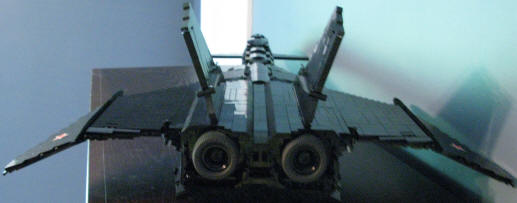
 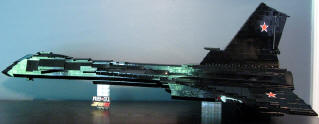


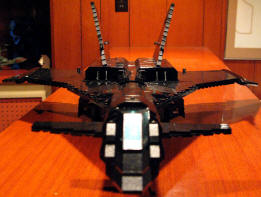 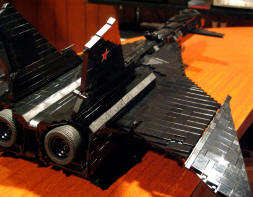
 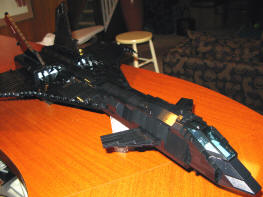
Model dimensions
(approx.): 32” L x 23” W x 9” H
[NOTE: the cockpit canopy, canards, front & rear landing
gear, airbrakes, fuel dual-intake hatch, flaps, and
dual missile
baydoors (housing 2 missiles each),
of this model
are fully
retractable.
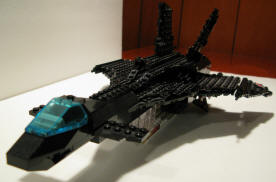 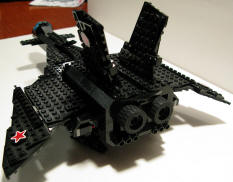

The Firefox is also
available in a mid-sized model (above).
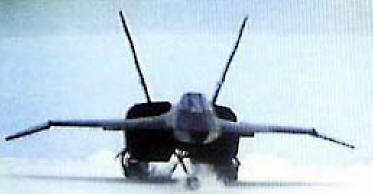 
Actual MiG-31 Firefox |
An authentic-to-scale replica of the MiG-31 Firefox.
Technical Specifications:
Designation: MiG-31
NATO Codename: Firefox
Nation of Origin: USSR
Manufacturer: Mikoyan-Gurevich
Type: Advanced Interceptor
Power-plant: 2 Tumansky RJ
-15BD-600 high-bypass
afterburning turbojets
producing
50,000 lbs. of thrust each; 6
Soyuz/Komarov solid rocket
boosters producing an additional
15,900 lbs. of thrust combined
Max Speed: 3,568 mph (Mach 5+)
Max Ceiling: 120,500'
Range: 3,000 nautical miles
Crew: 1
Armament: 4 AA-11 Acrid air-to
-air guided missiles; twin 23mm
cannons
Defense: 4 rearward pods armed
with anti-missile chaff/flare
dispensers; Electronic
countermeasures (ECM) to jam
enemy radar
Airframe: angular titanium /
stainless steel / nickel alloy;
"Cranked Arrow" wing platform;
Radar Absorbent Material (RAM)
The aircraft is
revolutionary both in terms of its "stealth" (i.e., virtually
undetectable to enemy radar) and
its flight-handling capabilities. Capable of a maximum speed of
Mach 6,
it is the fastest aircraft ever built.
The
aircraft's most infamous feature is its Thought-Controlled Weapons
System, which uses a special helmet to detect signals from the
pilot's brain to target enemies and fire weapons. However, it only
responds to commands thought in the "Russian" language.
Further innovations include: the "Cranked Arrow" wing
design (that improves aerodynamics and lift); internal missile
bays (housing missiles hidden within the fuselage); onboard
camera system (that allows the pilot to see images on his console
ahead of, below, and directly behind the aircraft); and retractable airbrakes
(used to abruptly slow down the aircraft during dogfighting, etc.).
The aircraft's only
downfall is that its massive dual Tumansky engines produce a prominent heat
signature detectable by enemy infra-red-guided missiles (albeit it has
been known to out-run the effective range of enemy ground-to-air
missiles).
|
|
Star Trek’s Klingon
Bird-of-Prey
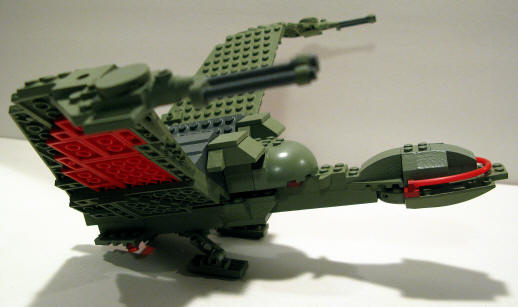
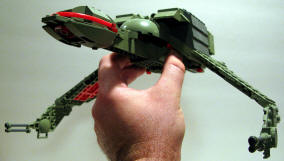 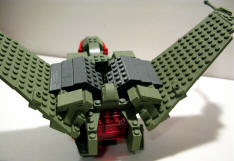

 
Model dimensions (approx.):
10” L x
11.5” W x 7” H (with its
wings in the downward attack position)
[NOTE: the model's wings
are
moveable to the upward,
neutral or downward
positions.
The model can be equipped
with landing gear (as shown), mounted on
a stand (also
shown) or suspended in mid-air with
invisible line.]
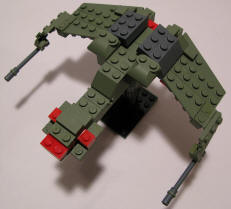 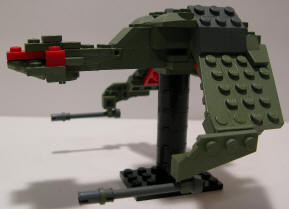
The Bird-of-Prey is also
available in a micro-sized model
(above), which has
wings
that
are
moveable to the
neutral or
downward
positions.

Orthographic views of actual Bird-of-Prey
|
An authentic-to-scale replica of Star Trek’s
most elegant yet feared battle-cruiser-class starship, the Klingon Bird-of-Prey.
The Bird-of-Prey is aptly named due to the
bird-like shape of its wings and hull, and its ability to cloak (i.e.,
turn virtually invisible), hunt-down and destroy enemy vessels.
It has
a length of 110 metres, carries a crew of 12 to 36 men, and travels
at a maximum speed of warp 9+.
Its armament consists of one
photon torpedo launcher and 2 disruptor canons.
Its defenses
consist of deflector shields and a cloaking device (that
renders the ship virtually invisible until it powers-up its weapons to
attack).
The ship’s wings move in an upward position (for takeoff and landing),
a neutral position (for normal flight), and the classic downward
position for purposes of attack.
There is potential for
creating additional popular starships of Star Trek (e.g., the
Federation of Planet’s Enterprise and the Romulin WarBird).
|
|
A Mech
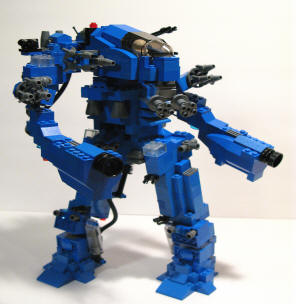 
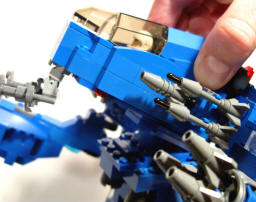 
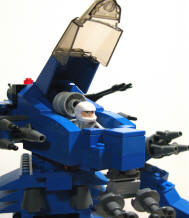 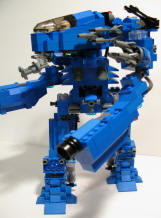 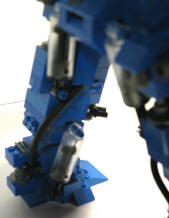
Model dimensions
(approx.): 8” L x
8.5” W x 12” H
[NOTE: the model can be posed in a variety of positions thanks to its
tilting, 360˚ rotating upper torso, bendable shoulder and elbow joints, and
bendable, piston-actuated hip and ankle joints. The model's transparent cockpit
window swivels upward to reveal one standard-sized LEGO spaceman at
the helm of the stick and computer console.]
|
An imposing, futuristic,
human-piloted, heavily armed and armoured, mechanical battle robot of
war, which stands 50 feet tall.
Power is supplied by a nuclear main
reactor core (located and partially visible within the lower torso)
and
dual power generators (located within the cockpit directly behind
the pilot's seat), and is transmitted via heavy cabling throughout the body.
The Mech’s
upper torso can tilt, and swivel a complete 360˚
in order to aim and discharge its primary weapon, namely 2
heavy-laser canons (one within each arm). The Mech's
secondary weapons include: guided, short- (6), medium- (2) and long- (4)
range, tactical nuclear ballistic missiles, and 2 dual medium-laser
canons (mounted on each shoulder). Additional weapons
include: dual quad-barrel rotating gatling guns
with exploding tracer rounds (mounted below the nose of the cockpit), and
4 dual small-laser guns (mounted on the
legs and particularly effective against infantrymen).
Defenses consist of a deflector shield
grid (generated by shield modulators located on the arms, torso and
legs),
reinforced titanium armour plating, and Radar Absorbent Material (RAM).
The Mech is
capable of walking, running and jumping, wading through shallow lakes and
streams, and crushing anything in its wake (e.g., large trees, enemy
forces, etc.). Onboard turbojets provide full
flight capability for entering and exiting the battlefield, and limited
flight capability during battle.
The mech's only
downfall is potential over-heating (and resultant temporary shutdown of
one or more systems) caused by the tremendous heat build-up that
inevitably occurs as it rapidly discharges
its weapons during battle (albeit onboard vents effectively dissipate
the heat in all but extreme situations).
There is potential for
creating additional Mechs having varying colours, shapes, sizes and
weapon systems. |
|
Buck Rogers Earth
Defense Directorate's Starfighter
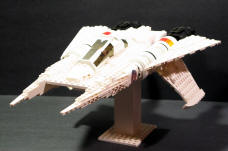 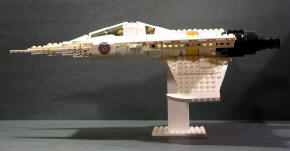
 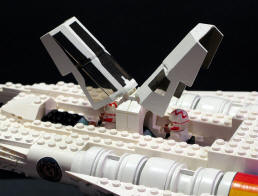
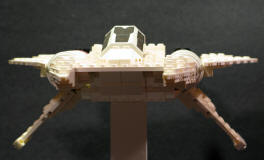 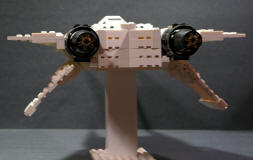
Model dimensions
(approx.): 15.5” L x
9.5” W x 6.25” H
[NOTE: The model's transparent front- and rear-cockpit canopies swivel upward to reveal
2 standard-sized spacemen (pilot and co-pilot) at
the helm of the dual sticks and computer consoles (as shown).
Alternatively, the rear-cockpit can serve as a passenger/cargo hold
(without a stick and computer console if desired).]
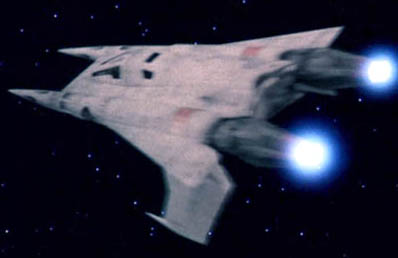
Actual starfighter |
An authentic-to-scale replica of Buck
Rogers Earth Defense Directorate's starfighter. The fighter was
commissioned and has been mass produced to protect the Earth and her
government's in-service fleet of starships.
Technical Specifications:
Designation: ED-SF-012
Nation of Origin: Earth
Manufacturer: Earth Defense Directorate
Class: fighter
Power-plant: 2 ion engines powered by a hydrogen
fusion reactor (uses a stargate to travel interstellar
distances)
Cargo: back aft-facing cockpit (4 ft x 4.5 ft x 4 ft) used
for emergency equipment and weapons, or to transport a
passenger
Max Speed: approaching the speed of light (warp 1)
Range: 800 miles (1,290 km) in space (less if in an
atmosphere)
Crew: 1 in front cockpit (but can fit 1 co-pilot/passenger
in the aft-facing back cockpit)
Flight control: manual (preferred) or automatic combat
Armament: 8 laser cannons (that fire simultaneously in
sink); 2 (optional) anti-ship missiles (mounted on the
underbelly)
Defense: deflector shield
Airframe: twin delta wing
Systems: life support and internal gravity
The fighter comprises front-, and back-
aft facing, cockpits interjecting a twin boom construction. Each
boom has a sharp-nosed front (that houses 4 laser cannons) and an ion
engine mounted in the rear.
The fighter is very fast,
maneuverable and heavily armed. The fighter can launch and
land under its own power but often uses an electromagnetic launch system
to reach a greater initial velocity than would otherwise be possible.
The starfighter's only
downfall is its automatic combat mode program, designed and intended to
fight better than the pilots themselves. This program was found to
be too predictable in battle and is normally abandoned in favour of full
manual flight control mode. |
|
Lockheed SR-71 Blackbird
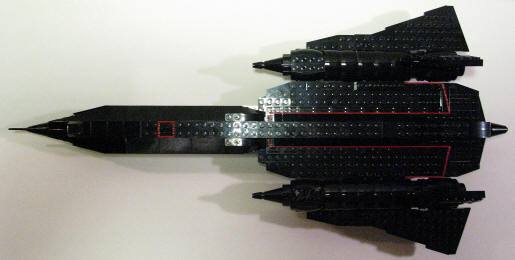
 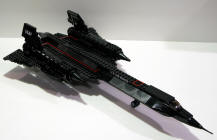
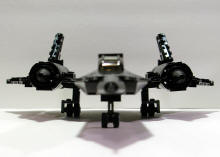 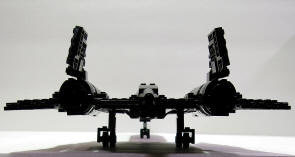
Model dimensions
(approx.): 20” L x 10.25” W x 6.25” H
[NOTE: the landing gear
of this model
is fully retractable. The plane can be displayed sitting on
its landing gear (as shown) or placed on stands in an angled in-flight
pose with its landing gear up.]
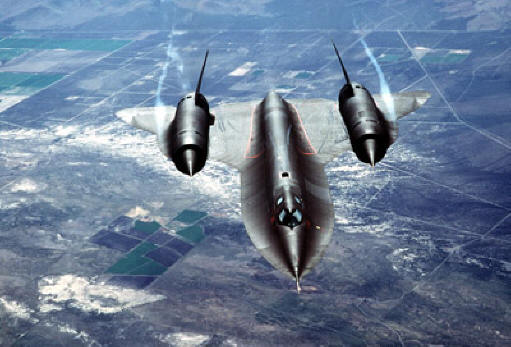
Actual SR-71 Blackbird
|
An authentic-to-scale replica of the
Lockheed SR-71 Blackbird.
Technical Specifications:
Designation: SR-71
Call sign: Blackbird
Nation of Origin: USA
Manufacturer: Lockheed
Type: SR (strategic reconnaissance)
Power-plant: 2 Pratt & Whitney JT11D-20B turbofans
(continuous afterburning) with 32,500 lbs of thrust
each
Max Speed: Mach 3+ (2,190+ mph)
Max Ceiling: 26+ km (85,000+ feet), i.e., the extreme
edges of Space
Range: 2,982 nautical miles (4,800 km)
Crew: 2
Armament: None
Defense: Electronic Countermeasures (ECM) for
countering missile and airborne fighter threats
Airframe: delta wings, titanium and titanium alloys (to
cope with enormous temperature fluctuations); Radar
Absorbent Material (RAM)
Payload: 3,500 lbs (1,600 kg) of sensors including:
optical/infrared imagery systems, side-looking airborne radar (SLAR),
electronic intelligence (ELINT) gathering systems, and
recorders
In service almost 40 years after its
inception, the Blackbird remains the highest-flying, fastest aircraft ever
produced. Originally, the Blackbird was to be weaponized but was converted into a spy plane
because it flew faster than a rifle bullet (i.e., it would
have shot itself down). Although equipped with ECM, the SR-71's greatest protection was
its high top speed, which made it virtually invulnerable to attack. Over the course of its service life, not
one was shot down, despite numerous attempts by the Soviets to do so.
Basically all the pilot had to do when a surface-to-air missile (SAM)
was fired was to accelerate. Landing one was impossible without
the deployment of an onboard parachute to slow it down.
The premier reconnaissance plane, the
SR-71 actually flew over Russian airspace photographing sensitive sites
at the height of the Cold War. It can photograph a license plate
from a cruising altitude of 26 km, and can map 110,000 square miles per
hour.
The Blackbird incorporated many interesting
features. The aircraft was painted a dark blue, almost black, to increase the emission of internal heat, to act as camouflage against the night sky, and to resist visible light and radar detection. "Chines" (sharp edges
along the sides of the nose and fuselage)
generate improved lift and aerodynamics. "Spikes" (movable
pointed cones in front of the engine air inlets) directed incoming air
to maximize thrust. The spikes were locked in the full forward
position when in subsonic flight. During acceleration to
high-speed cruise, the spikes would unlock and begin a gradual
mechanical (internal jack-screw actuated) aft descent up to 26 inches
(66 cm). A corrugated titanium sheathing was used on
sections of the wings because it expands/contracts better than other
conventional materials. JP-7 jet fuel was used as a coolant and
hydraulic fluid before being burned.
The aircraft's only
downfalls are: its poor fuel efficiency (it often requires frequent
in-flight refueling); and its accident proneness due to its high speed. |
|
Death Machine
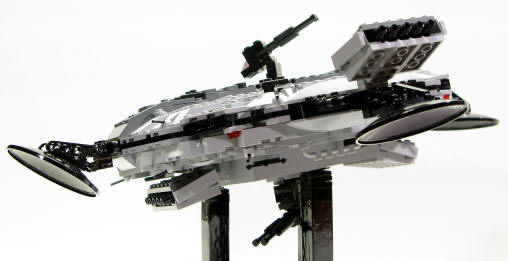
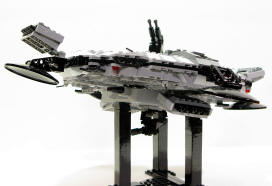 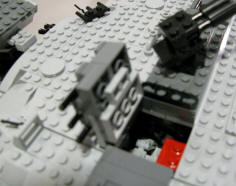
 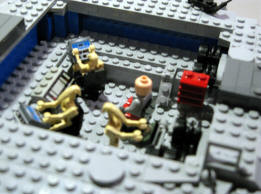
Model dimensions
(approx.): 14.5” L x 14.5” W x 8.5” H
[NOTE: the model has a retractable entry/exit hatch, and a
removable ceiling that reveals the human and droid crew inside.]
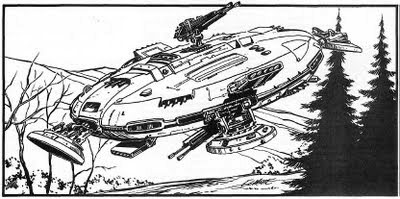
Actual Death Machine
|
An imposing, futuristic,
human- or droid-piloted, heavily armed and armoured, machine of
war.
Technical Specifications:
Locomotion: inductors (top speed: 100 mph)
Defense: force field, megatanium-armoured hull
Sensors: nerve web (range: 6 miles); 360˚ view screen
Weaponry: 2 blaster cannons (max. range 9,000’); 6
black ray exterminator cannons (max. range 900’;
instant death to living targets not protected by a force
field); 16 batteries of 4 fusion rifles each (max.
range of 9,000’); 4 plasma guns (max. range 600’);
8 laser batteries of 5 guns each (max. range 9,000’); 6
micro-missile tubes with 100 missiles each; 1
mini-missile launcher with 50 missiles; energy damping
field (all electrical systems within a 150’ radius, not
protected by a force field, are disabled)
Power-plant: nuclear fusion reactor core
The death machine's energy dampening
field makes it virtually invulnerable to all enemy machines/robots governed
by electrical systems (unless they are protected by a force field).
The machine is infamous for its high-speed, stealth, and ability to
attack multiple heavy targets by deploying a multitude of lasers and
ordinances. Indeed, when one of these aptly-named weapons
platforms comes humming over the horizon, it’s time to run and hide and
pray that it passes you by!
The machine's only
downfall is that they are extremely rare and if you are lucky enough to
obtain one it is unlikely to be in pristine working condition and fully weaponized (i.e., guns/cannons may be inoperable, missiles depleted,
etc.).
|
|
Terminator
H-K Tank
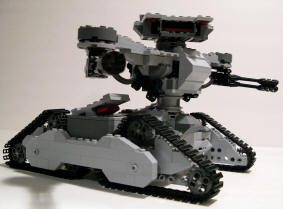 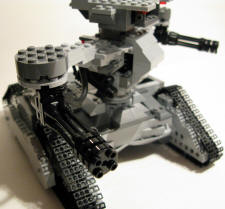
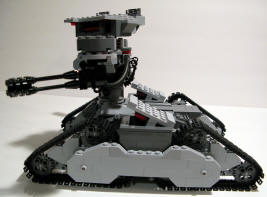 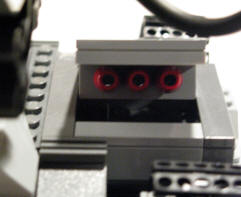
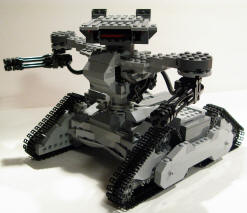 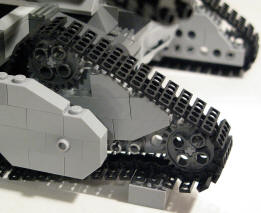
 
Model dimensions
(approx.): TBD (” L x ” W x ” H)
[NOTE: the model has 4 working, independent suspension tank treads,
2 moveable and rotating quad-barreled heavy plasma cannons, and
2 retractable missile bays containing 3 micro-missiles each.]
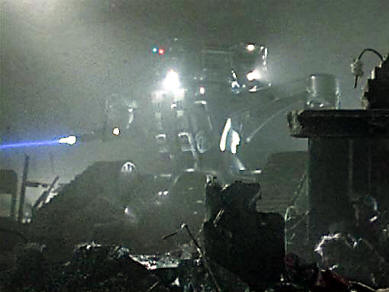
Actual H-K Tank
|
An authentic-to-scale replica of the
Hunter-Killer Tank, from the "Terminator" movie series. The
H-K Tank is one of
Skynet's non-humanoid
hunter-killers and is its
principal ground-based combat assault vehicle.
Known to have variants, the
HK-Tank is several stories tall and vaguely humanoid in overall
shape, possessing a rotating, tower-like "head", two steel "arms"
equipped with two-barreled directional plasma
cannons (the particular variant shown has been upgraded with
quad-barreled directional rotary heavy plasma cannons, and
with 2 retractable missile bays containing 3 micro-missiles
each), and 4 "legs" consisting of massive individual tank treads.
The H-K Tank's weapons guidance
system, governed by its photographic infra-red spectrum and GPS
targeting, is acutely tuned to tracking humanoid targets. Any
targets fortunate enough to escape unscathed are inevitably crushed
by the tank's massive independent suspension tank treads.
Although formidably armed, the HK-Tank
can be destroyed by a well-placed demolition charge. Given
the increase of this and other effective anti-tank tactics used by
the
Resistance to not only disable
these units but also to scavenge them for heavy weapons, power
sources, and armor, Skynet has started equipping some units with
crew compartments, containing concealed
endoskeletons to counterattack the
human assault teams.
|
|
Ark of the Covenant
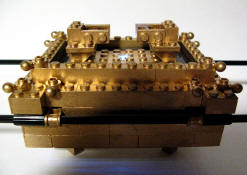 
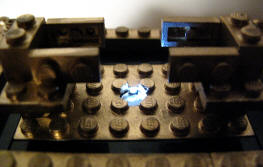 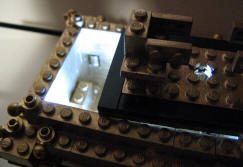
Model dimensions
(approx.): 7.5” L x 4.25” W x 3.75” H
|
An interpretation of the sacred, biblical,
gold-gilded ark (chest), which has a Mercy Seat (lid) that is adorned
by two opposing cherubim (angels) with outstretched wings, with
rings for the carrying poles.
The ark’s primary function was to act as a
communicator (at the location where the two opposing angels’
outstretched wings meet) between God and Moses. The ark also housed
the sacred stone tablets bearing the Ten Commandments of God.
This ancient ark acted much like a
gigantic modern day “capacitor”, capable of harnessing the energy from
the earth’s magnetic field to electrocute an unwary intruder.
The ark, if properly handled or grounded to the earth, can be safely
opened to reveal the sacred LEGO stone tablets inside (not shown).
|
|
Trebuchet
 
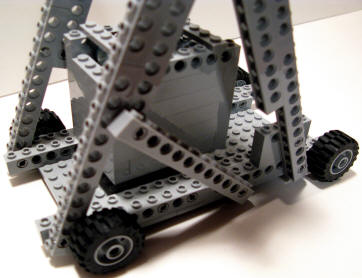 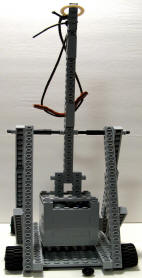
|
An authentic, fully functional, reproduction of
the infamous and deadly Trebuchet; a medieval machine of war
capable of hurling large boulders (in this case a small plastic LEGO
ball) or flaming projectiles, to destroy an enemy castle’s walls.
The machine uses a heavy counterweight pendulum,
and is thereby considered superior to the traditional catapult, to
generate tremendous throwing force (i.e., the LEGO ball can be thrown
a maximum distance of about 15-20 feet). |
|
Novelty + Utility + Ingenuity = Invention
™